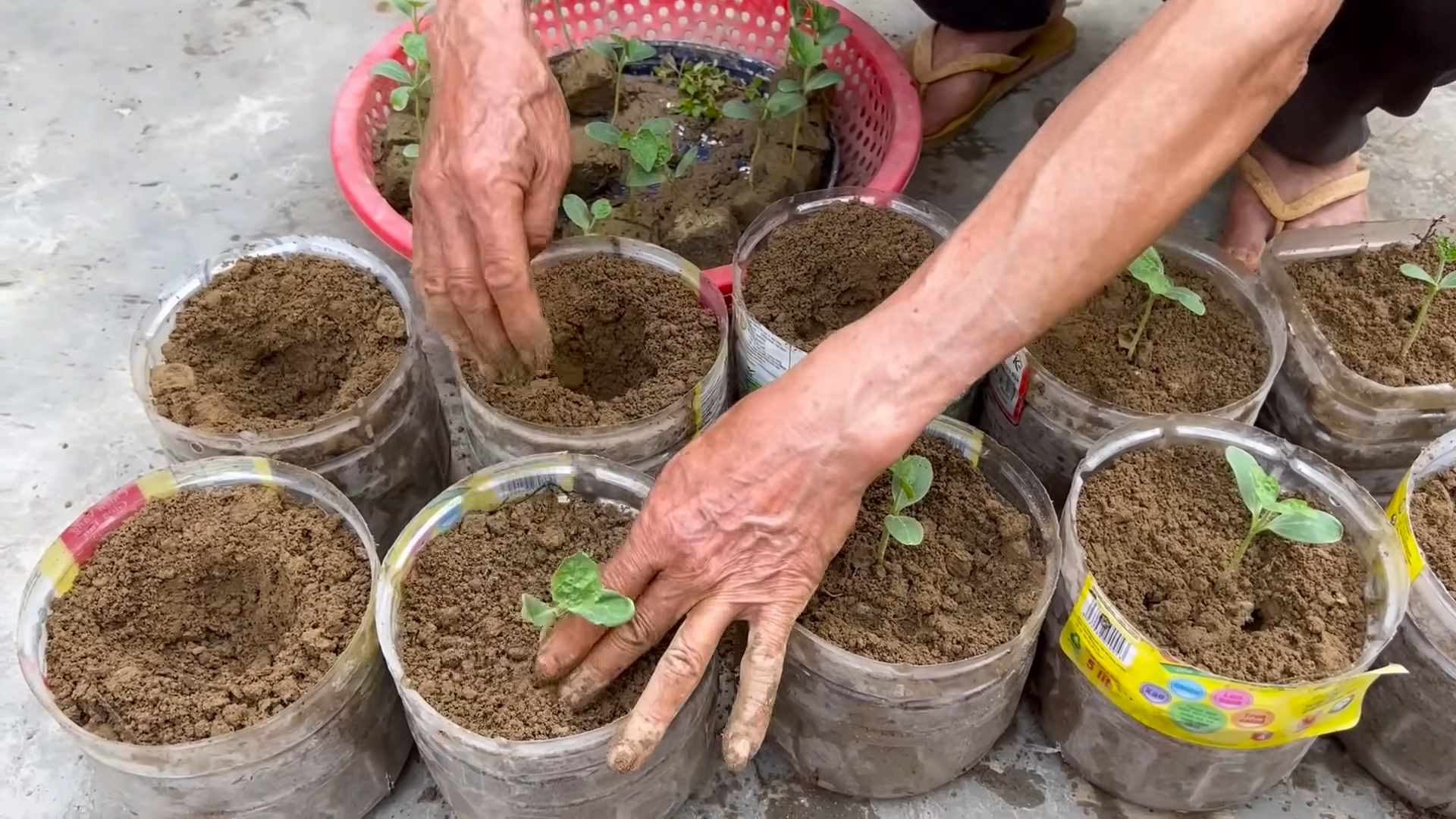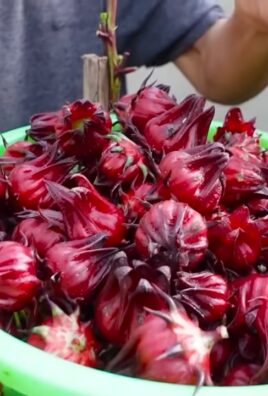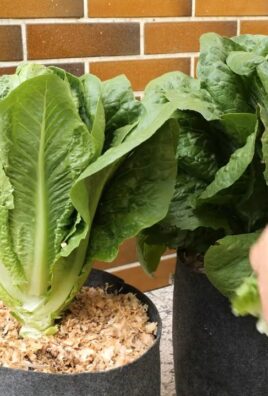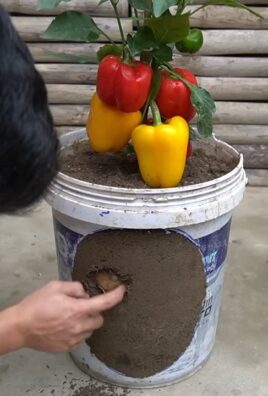Grow Watermelons Easily? Absolutely! Imagine biting into a juicy, sweet, homegrown watermelon on a hot summer day. Sounds idyllic, right? Well, it doesn’t have to be just a dream! For centuries, watermelons have been a symbol of summer, abundance, and refreshment, tracing their roots back to Africa where they were prized for their hydrating properties. Now, you might think growing these giants is only for experienced farmers with acres of land, but I’m here to tell you that’s simply not true!
This article is packed with DIY tricks and hacks that will empower you to grow watermelons easily, even if you have limited space or a less-than-green thumb. We’ll demystify the process, breaking it down into simple, manageable steps. Why do you need these tricks? Because store-bought watermelons often lack the flavor and freshness of homegrown ones, and let’s be honest, there’s nothing quite as satisfying as nurturing a plant from seed to delicious fruit. Plus, you’ll know exactly what went into growing your watermelon, avoiding any unwanted chemicals or pesticides. So, get ready to roll up your sleeves and discover the secrets to a bountiful watermelon harvest!

Grow Watermelons Like a Pro: My Foolproof DIY Guide
Okay, so you want to grow watermelons? Awesome! I’m here to tell you it’s totally doable, even if you don’t have a sprawling farm. I’ve had some amazing success with watermelons in my own backyard, and I’m going to share all my secrets with you. Get ready for juicy, homegrown goodness!
Choosing the Right Watermelon Variety
First things first, let’s talk about watermelon varieties. Not all watermelons are created equal, and choosing the right one for your climate and space is crucial.
* **Consider your climate:** Some varieties thrive in hot, humid conditions, while others are more tolerant of cooler temperatures.
* **Think about space:** If you have limited space, opt for bush or compact varieties. Vining watermelons need a lot of room to spread out.
* **Check the growing season:** Make sure the variety you choose has a growing season that fits your region’s climate.
Here are a few of my personal favorites:
* **Sugar Baby:** A classic, small, and sweet watermelon that matures quickly. Perfect for smaller gardens.
* **Crimson Sweet:** A larger, oblong watermelon with a vibrant red flesh. It’s known for its disease resistance.
* **Yellow Doll:** A unique watermelon with yellow flesh that’s incredibly sweet and crisp.
* **Bush Sugar Baby:** A compact version of the Sugar Baby, ideal for container gardening.
Preparing Your Garden Bed
Watermelons are heavy feeders, so preparing your garden bed properly is essential for a bountiful harvest.
* **Sunlight:** Watermelons need at least 6-8 hours of direct sunlight per day. Choose a location that gets plenty of sun.
* **Soil:** Watermelons prefer well-drained, sandy loam soil with a pH between 6.0 and 6.8.
* **Amendments:** Amend your soil with plenty of organic matter, such as compost or well-rotted manure. This will improve drainage, fertility, and water retention.
Step-by-Step Planting Guide
Now for the fun part – planting! You can either start your watermelon seeds indoors or direct sow them in your garden. I usually prefer to start them indoors to get a head start, especially in cooler climates.
Starting Seeds Indoors (Optional)
1. **Timing is key:** Start your seeds about 4-6 weeks before the last expected frost.
2. **Choose your containers:** Use peat pots or biodegradable containers to avoid disturbing the roots when transplanting.
3. **Sowing the seeds:** Fill the containers with a seed-starting mix and sow 2-3 seeds per pot, about 1 inch deep.
4. **Watering:** Water gently to moisten the soil, but don’t overwater.
5. **Warmth and light:** Place the containers in a warm location (around 70-80°F) and provide plenty of light. A heat mat can help speed up germination.
6. **Thinning:** Once the seedlings emerge, thin them to one plant per pot.
Direct Sowing Seeds
1. **Wait for warm weather:** Make sure the soil temperature is at least 70°F before direct sowing.
2. **Prepare the soil:** Create small mounds or hills in your garden bed, about 3-4 feet apart.
3. **Sow the seeds:** Sow 4-5 seeds per hill, about 1 inch deep.
4. **Watering:** Water gently to moisten the soil.
5. **Thinning:** Once the seedlings emerge, thin them to the strongest 2-3 plants per hill.
Transplanting Seedlings
1. **Harden off:** Before transplanting, gradually acclimate your seedlings to outdoor conditions by exposing them to increasing amounts of sunlight and fresh air over a week or two.
2. **Choose a cloudy day:** Transplant on a cloudy day to minimize stress on the plants.
3. **Dig the holes:** Dig holes that are slightly larger than the root balls of your seedlings.
4. **Gently remove the seedlings:** Carefully remove the seedlings from their containers, being careful not to damage the roots.
5. **Plant the seedlings:** Place the seedlings in the holes and backfill with soil.
6. **Water thoroughly:** Water the seedlings thoroughly after transplanting.
Caring for Your Watermelon Plants
Watermelons need consistent care to thrive. Here’s what you need to do:
* **Watering:** Water deeply and regularly, especially during hot, dry weather. Aim for about 1-2 inches of water per week. Avoid overhead watering, as this can promote fungal diseases. Drip irrigation is ideal.
* **Fertilizing:** Fertilize your watermelon plants every 2-3 weeks with a balanced fertilizer. You can also side-dress with compost or well-rotted manure.
* **Weeding:** Keep your garden bed free of weeds, as they can compete with your watermelon plants for nutrients and water.
* **Mulching:** Apply a layer of mulch around your plants to help retain moisture, suppress weeds, and regulate soil temperature. Straw, wood chips, or black plastic mulch are all good options.
* **Pruning (Optional):** Some gardeners prune their watermelon vines to encourage larger fruit. If you choose to prune, remove any suckers (small shoots that grow from the base of the plant) and any damaged or diseased leaves.
* **Pollination:** Watermelons need to be pollinated to produce fruit. If you’re not seeing any fruit set, you may need to hand-pollinate the flowers. To do this, use a small paintbrush to transfer pollen from the male flowers to the female flowers. Female flowers have a small fruit at the base of the flower.
Dealing with Pests and Diseases
Watermelons can be susceptible to a few pests and diseases. Here’s how to deal with them:
* **Squash bugs:** These pests can suck the sap from your watermelon plants, causing them to wilt and die. Handpick them off the plants or use an insecticidal soap.
* **Cucumber beetles:** These beetles can transmit diseases to your watermelon plants. Use row covers to protect your plants or spray them with an insecticide.
* **Aphids:** These small, sap-sucking insects can weaken your watermelon plants. Spray them with a strong stream of water or use an insecticidal soap.
* **Powdery mildew:** This fungal disease can cause a white, powdery coating on the leaves of your watermelon plants. Improve air circulation and spray with a fungicide.
* **Fusarium wilt:** This soilborne disease can cause your watermelon plants to wilt and die. Choose disease-resistant varieties and practice crop rotation.
Harvesting Your Watermelons
Knowing when to harvest your watermelons is crucial for getting the best flavor and texture. Here are a few signs that your watermelons are ripe:
* **The tendril closest to the fruit turns brown and dry.**
* **The bottom of the watermelon (where it rests on the ground) turns from white to yellow.**
* **The watermelon sounds dull and hollow when you thump it.**
* **The rind is hard and difficult to penetrate with your fingernail.**
To harvest your watermelons, use a sharp knife to cut the stem close to the fruit. Handle the watermelons carefully to avoid bruising them.
Tips and Tricks for Watermelon Success
Here are a few extra tips and tricks that I’ve learned over the years:
* **Elevate your watermelons:** Place your watermelons on a bed of straw or cardboard to prevent them from rotting on the ground.
* **Water deeply but infrequently:** This encourages deep root growth, which will make your plants more drought-tolerant.
* **Protect your watermelons from sunburn:** If you live in a hot climate, you may need to shade your watermelons from the intense sun. You can use shade cloth or simply drape a towel over the fruit.
* **Rotate your crops:** Avoid planting watermelons in the same location year after year, as this can increase the risk of soilborne diseases.
* Don’t be afraid to experiment! Every garden is different, so don’t be afraid to try different varieties and techniques to see what works best for you.
Enjoying Your Homegrown Watermelons
Congratulations! You’ve successfully grown your own watermelons. Now it’s time to enjoy the fruits (or rather, vegetables) of your labor.
* **Chill your watermelons:** For the best flavor, chill your watermelons in the refrigerator for a few hours before eating.
* **Cut and serve:** Cut your watermelons into wedges, cubes, or balls.
* **Get creative:** Use your watermelons in salads, smoothies, or even grilled dishes.
* **Share with friends and family:** There’s nothing better than sharing your homegrown watermelons with loved ones.
Growing watermelons can be a rewarding experience. With a little bit of planning and effort, you can enjoy

Conclusion
So, there you have it! Growing watermelons, those juicy symbols of summer, doesn’t have to be an exercise in frustration. By implementing this simple yet effective DIY trick, you’re setting yourself up for a bountiful harvest of sweet, refreshing fruit. We’ve demystified the process, offering a practical solution to common watermelon-growing challenges. This isn’t just about growing watermelons; it’s about empowering you to take control of your garden and enjoy the fruits (literally!) of your labor.
Why is this DIY trick a must-try? Because it addresses the core needs of watermelon plants: consistent moisture, warmth, and protection from pests and diseases. By focusing on these elements, you’re creating an optimal environment for your watermelons to thrive, leading to larger, healthier, and more flavorful fruits. Forget complicated gardening techniques and expensive equipment. This method is accessible to gardeners of all skill levels, from seasoned pros to complete beginners. It’s a cost-effective way to boost your watermelon yield and enjoy the satisfaction of growing your own food.
Looking for variations? Consider experimenting with different types of mulch. While black plastic mulch is excellent for warming the soil, organic mulches like straw or wood chips can also be used, especially in warmer climates. These organic options will decompose over time, enriching the soil and providing additional nutrients to your watermelon plants. You can also adapt this trick for other vining crops like cantaloupe or pumpkins. The principles of consistent moisture and warmth apply to many cucurbits, making this a versatile gardening technique. Another variation is to use a soaker hose instead of drip irrigation for watering. This can be particularly useful if you have a large area to cover. Just be sure to monitor the soil moisture levels to avoid overwatering.
We wholeheartedly encourage you to try this DIY trick for growing watermelons. The results speak for themselves. Imagine biting into a perfectly ripe, homegrown watermelon, knowing that you nurtured it from seed to table. It’s a rewarding experience that connects you to nature and provides a delicious, healthy treat for you and your family.
Don’t just take our word for it. Give it a try and see the difference for yourself. We’re confident that you’ll be amazed by the results. And most importantly, we want to hear about your experience! Share your photos, tips, and stories with us in the comments below. Let’s create a community of watermelon enthusiasts who are passionate about growing their own delicious fruit. Let us know what worked for you, what challenges you faced, and any modifications you made to the technique. Your feedback will help us refine this DIY trick and make it even more effective for other gardeners. So, get out there, get your hands dirty, and start growing some amazing watermelons! Happy gardening!
Frequently Asked Questions (FAQ)
What type of watermelon is best suited for this DIY trick?
This DIY trick is generally effective for most watermelon varieties, but smaller to medium-sized watermelons tend to perform best, especially for beginner gardeners. Varieties like Sugar Baby, Bush Sugar Baby, or Yellow Doll are excellent choices because they mature relatively quickly and don’t require as much space as larger varieties. However, you can certainly try this method with larger varieties like Crimson Sweet or Jubilee, just be sure to provide adequate support for the developing fruits and ensure they have enough space to grow. Consider the climate you live in when choosing your watermelon variety. Some varieties are better suited for warmer climates, while others can tolerate cooler temperatures. Research the specific needs of your chosen variety to ensure the best possible results.
How often should I water my watermelons using this method?
Watering frequency depends on several factors, including the weather, soil type, and the size of your watermelon plants. As a general rule, water deeply and less frequently, rather than shallowly and often. Aim to keep the soil consistently moist, but not waterlogged. Check the soil moisture levels regularly by sticking your finger about an inch or two into the soil. If the soil feels dry to the touch, it’s time to water. During hot, dry weather, you may need to water every day or every other day. During cooler, wetter weather, you may only need to water once or twice a week. The key is to monitor the soil moisture levels and adjust your watering schedule accordingly. Using a moisture meter can also be helpful in determining when to water.
Can I use this DIY trick in containers?
Yes, you can adapt this DIY trick for growing watermelons in containers, but you’ll need to make some adjustments. Choose a large container, at least 20 gallons in size, to provide enough room for the watermelon roots to grow. Ensure the container has drainage holes to prevent waterlogging. Use a high-quality potting mix that is well-draining and rich in nutrients. Place the container in a sunny location that receives at least 6-8 hours of direct sunlight per day. Water regularly, as containers tend to dry out more quickly than garden beds. You may also need to fertilize your watermelon plants more frequently when growing them in containers, as the nutrients in the potting mix will be depleted over time. Consider using a slow-release fertilizer or a liquid fertilizer diluted to half strength.
What if I don’t have access to black plastic mulch?
If you don’t have access to black plastic mulch, you can use other types of mulch, such as straw, wood chips, or even cardboard. While these materials won’t warm the soil as effectively as black plastic mulch, they will still help to retain moisture, suppress weeds, and regulate soil temperature. If you’re using organic mulch, apply a thick layer around your watermelon plants, making sure to keep the mulch away from the stems to prevent rot. You can also use clear plastic mulch, which will warm the soil but won’t suppress weeds as effectively as black plastic mulch. If you’re using cardboard, make sure to remove any tape or labels and overlap the pieces to create a solid barrier.
How do I protect my watermelons from pests and diseases?
Protecting your watermelons from pests and diseases is crucial for a successful harvest. Regularly inspect your plants for signs of pests, such as aphids, squash bugs, or cucumber beetles. If you find any pests, you can try hand-picking them off the plants or using insecticidal soap or neem oil. To prevent diseases, ensure good air circulation around your watermelon plants by spacing them properly and pruning any overcrowded foliage. Avoid overhead watering, as this can create a humid environment that promotes fungal growth. You can also use a fungicide to protect your plants from common watermelon diseases, such as powdery mildew or anthracnose. Choose a fungicide that is specifically labeled for use on watermelons and follow the instructions carefully. Consider using row covers to protect your young watermelon plants from pests and diseases early in the season.
When is the best time to harvest my watermelons?
Knowing when to harvest your watermelons is essential for enjoying their full flavor and sweetness. There are several indicators that can help you determine when your watermelons are ripe. One of the most reliable signs is the tendril closest to the watermelon turning brown and dry. The spot where the watermelon rests on the ground, known as the ground spot, should also turn from white to a creamy yellow color. You can also thump the watermelon and listen for a deep, hollow sound. A ripe watermelon will sound dull and resonant, while an unripe watermelon will sound more metallic. Finally, the skin of a ripe watermelon will be dull and slightly waxy, rather than shiny and smooth. Once you’ve determined that your watermelon is ripe, carefully cut it from the vine, leaving a few inches of stem attached.





Leave a Comment